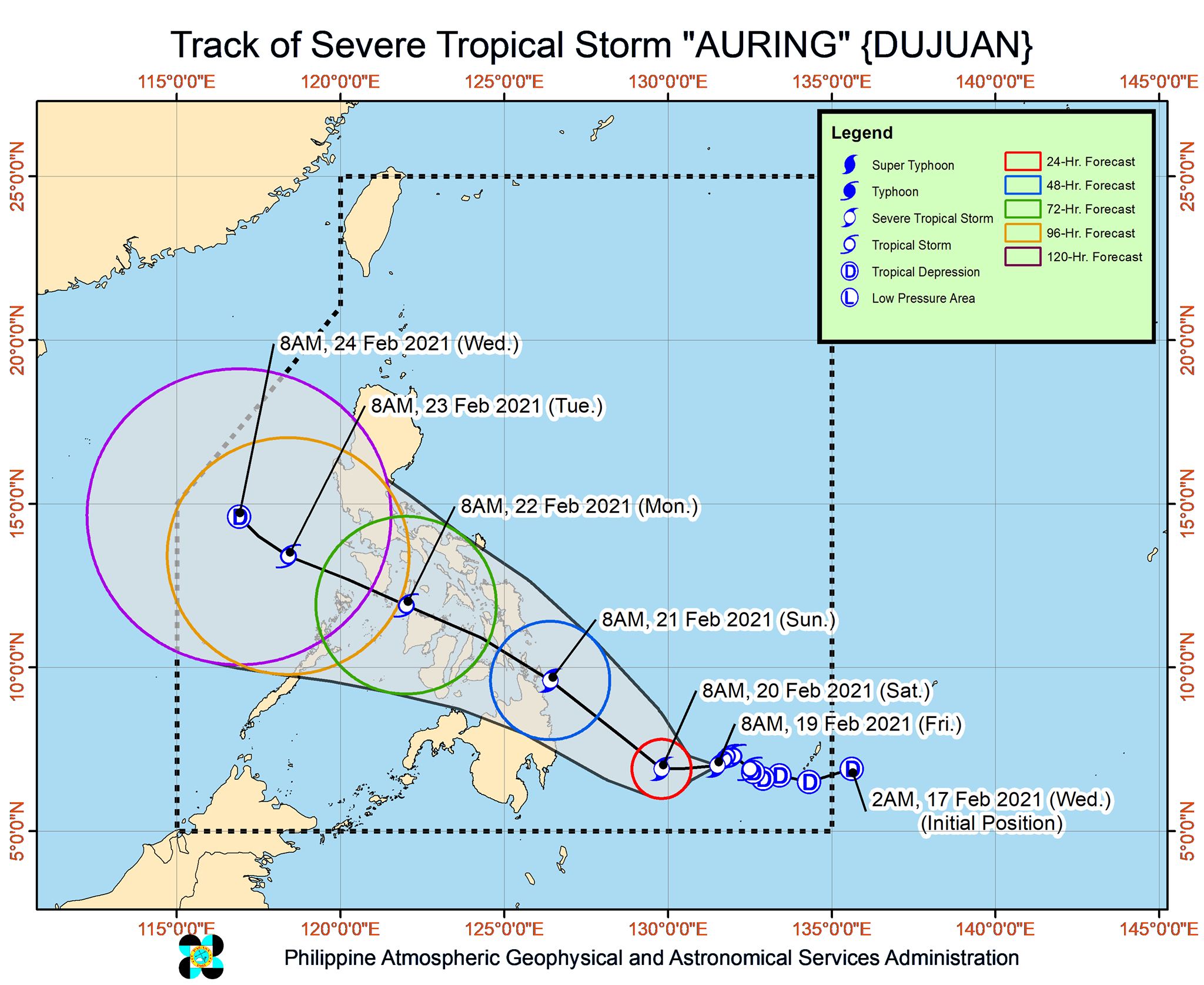
Auring (Dujuan) strengthened from a tropical storm into a severe tropical storm on Friday morning, February 19, as it continued to move slowly over the Philippine Sea.
In its 11 am bulletin on Friday, the Philippine Atmospheric, Geophysical, and Astronomical Services Administration (PAGASA) said Auring now has maximum sustained winds of 95 kilometers per hour (km/h) and gustiness of up to 115 km/h.
It remains “less likely” to intensify further into a typhoon at this time, according to the state weather bureau. (READ: FAST FACTS: Tropical cyclones, rainfall advisories)
Auring was last spotted 535 kilometers east southeast of Hinatuan, Surigao del Sur, slowly moving southwest. PAGASA said it is expected to speed up on Saturday morning, February 20.
The severe tropical storm’s latest forecast track shows a potential landfall in the eastern coast of the region of Caraga on Sunday morning, February 21. Once it makes landfall, it is likely to cross Caraga, the Visayas, and Mimaropa from Sunday to Monday, February 22.
PAGASA added that when Auring crosses land, it could weaken “due to significant terrain interaction and dry air intrusion from the northeast monsoon” or hanging amihan.
Though Auring is not yet near land, parts of Mindanao are already experiencing rain from the severe tropical storm. Here is PAGASA’s latest rainfall forecast for the next 48 hours:
Friday, February 19, until Saturday afternoon, February 20
Light to moderate rain, with at times heavy rain
- Caraga
- Davao Oriental
- Davao de Oro
- Davao del Norte
Saturday afternoon, February 20, until Sunday morning, February 21
Heavy to intense rain
- Caraga
Moderate to heavy rain, with at times intense rain
- Eastern Visayas
- Misamis Oriental
- Camiguin
- Bukidnon
- Davao del Norte
- Davao Oriental
- Davao de Oro
Light to moderate rain, with at times heavy rain
- rest of Visayas
- rest of Northern Mindanao
- Albay
- Sorsogon
- Catanduanes
- Masbate
- Lanao del Sur
- Cotabato
- Davao City
PAGASA urged residents to prepare for scattered to widespread flooding as well as landslides, which are “likely during heavy or prolonged rainfall.”
As for winds, these are the areas under Signal No. 1 as of 11 am on Friday, all located in Mindanao:
- Davao Oriental
- eastern part of Davao de Oro (Pantukan, Maragusan, New Bataan, Compostela, Monkayo)
- eastern part of Agusan del Sur (Sibagat, Bayugan City, Prosperidad, Talacogon, San Francisco, Rosario, Bunawan, Santa Josefa, Trento)
- Surigao del Sur
PAGASA said the areas under Signal No. 1 may experience “strong breeze to near-gale conditions” due to Auring starting Saturday at the earliest.
Note, however, that the surge of the northeast monsoon is already causing similar windy conditions in Northern Luzon and the eastern parts of Central Luzon, Southern Luzon, the Visayas, and Mindanao on Friday.
PAGASA said the highest tropical cyclone wind signal that may be raised due to Auring is Signal No. 2, “for potentially damaging gale-force to storm-force winds.” This is “based on current meteorological data.”

As for coastal waters, these are the expected conditions in the next 24 hours:
Rough to high seas
Travel is risky for all types of vessels
- eastern seaboard of Mindanao (waves 3 to 7 meters high)
Rough to very rough seas
Travel is risky for all types of vessels
- seaboards of Northern Luzon and eastern seaboards of Central Luzon, Southern Luzon, and Visayas (waves 3 to 6 meters high)
Moderate to rough seas
Small vessels must take precautionary measures, inexperienced mariners should avoid navigation
- rest of the seaboards of the Philippines (waves 1.2 to 3 meters high)
An average of 20 tropical cyclones form within or enter the Philippine Area of Responsibility (PAR) each year. (READ: LIST: PAGASA’s names for tropical cyclones in 2021)
These are PAGASA’s latest estimates for the number of tropical cyclones inside PAR in the next 6 months:
- February – 0 or 1
- March – 0 or 1
- April – 0 or 1
- May – 0 or 1
- June – 1 or 2
- July – 2 or 3
PAGASA earlier said La Niña is expected to continue until March 2021, causing above normal rainfall in the country. The onset of La Niña was declared in October 2020. – Rappler.com

Post a Comment